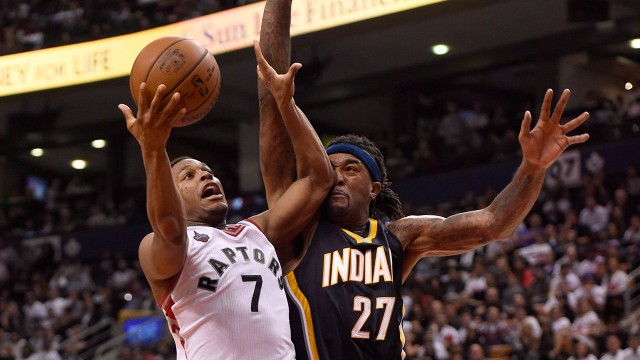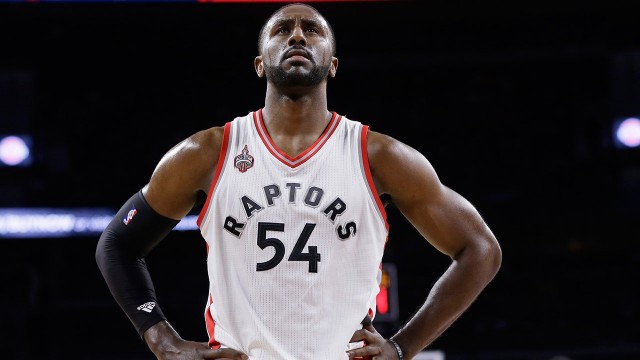TORONTO — Until he has a big scoring night in the post-season, DeMar DeRozan is likely to remain the biggest topic of conversation for Toronto Raptors observers. Forget about how integral he is this spring; his upcoming free agency is the biggest and most expensive question the team faces in the short term, a complicated query that defies both of the easiest answers: “let him walk” or “pay him the max without a second thought.” The longer he goes without going off, the easier it is to hedge toward the former opinion.
DeRozan did not play in the fourth quarter of the Raptors’ Game 2 win on Monday, and it was an understandable talking point, as it is tough to imagine many all-stars sitting in such a huge moment.
Lost in all of that, however, was the reason that he sat.
The lineup that played without him — well, a reasonable facsimile of that lineup — has been dynamite all season long. Kyle Lowry has been starting the second and fourth quarters playing with four reserves—Cory Joseph, Terrence Ross, Patrick Patterson and Bismack Biyombo— for months now, and it works splendidly. It did again on Monday. In the first half, the lineup was a plus-four. In the second half, with Powell in the injured Terrence Ross’s place, the lineup was a plus-seven. You might remember that the game’s final margin was, conveniently for this sentence, 11.
“Cory’s reading the game at a high level so that gives Kyle a chance to get off the ball and be more of a scorer,” DeRozan said on Tuesday. “You have Bismack out there, able to rebound and contest shots. Terrence, before I hit Terrence (at the end of the first half on Monday), he’s able to knock down shots. It’s just a deadly combination when our starters go out and that group come in to still feel confident. It’s big.”
The lineup has been a consistently stabilizing force for the Raptors. In 297 total minutes this season, it outscored opponents by 16.4 points per 100 possessions. Before Lowry is given too much credit, that group with DeRozan in Lowry’s place was the second-most effective Raptors lineup, with its advantage at 13.7 points per 100 possessions in 218 minutes. Of lineups that played at least 200 minutes together, Kyle And The Reserves had the fourth-best net rating in the league. Predictably, the three lineups ahead of them— one each from the Clippers, Warriors and Thunder— featured mostly starters and a bevy of all-stars.
While some of their success is based on playing against the second units of other teams, it is a group that has a strong internal logic going for it. Without a healthy DeMarre Carroll, the lineup features the most perimeter shooting the Raptors can put on the floor. Lowry, Ross and Patterson are the team’s three best high-volume three-point shooters. (Apologies to Luis Scola, who canned a team-best 40.4 per cent of his three-pointers this year. His slower release makes his burgeoning accuracy less valuable.) On the other end, the lineup maximizes switching ability with the team’s best rim protector, Biyombo.
“I think we play with a little more pace,” Joseph said of the lineup on Monday. “We get out, we run. We complement each other pretty well.”
Each of the five members serves a very specific role:
The Scorer: Kyle Lowry

In the lineup, Lowry morphs into a version of DeRozan. While Lowry is still involved in many pick-and-rolls, he is also the beneficiary of the screening and pindowns that DeRozan so often gets in the starting lineup. This is not just another way to get Lowry a clean jumper; it is another way to get Lowry into the paint, where he can make quick decisions, something he does better than any player on the team.
Little more needs to be said about Lowry. His immense value to the Raptors is, or should be, self-evident.
The tone setter: Cory Joseph

It is not as if Joseph becomes the de facto lead guard when he shares the floor with Lowry. In a lot of ways, their roles are interchangeable, save for the plays designed to create shots for Lowry.
However, Joseph does two things that help the lineup as a whole, and Lowry in particular: He splits pick-and-roll duties with Lowry and he picks up what is often the toughest defensive assignment on the perimeter. His shooting still needs to improve for him to be a viable starter in the league, but there is no question what he has meant to the Raptors, and their bench.
“He has been that warm blanket throughout the year,” Casey said.
The gunner: Terrence Ross

Ross’s game, and especially his defence, remains a frustration. He is essential to the unit, though. (If Powell’s late-season shooting surge continues, that becomes less true.)
If you are going to have Biyombo on the floor, a player who the Raptors’ opponents will abandon when Toronto has the ball, you need enough shooting on the floor to give Lowry and Joseph to work with when they do get into the paint. That is Ross. For all of his flaws, he shot 38.8 per cent from three-point range this season, and 41.3 per cent in the final three months of the year.
It is nice when Ross puts the ball on the floor and unleashes his floater. It is nice when he uses his athleticism to stay in front of his man in the pick-and-roll. All the Raptors really need from Ross is his shooting, and he has given it to them.
The deterrent: Bismack Biyombo

Lowry averaged 2.0 steals per 36 minutes this year. Part of that is random luck, and part of it is Lowry learning when are the best time to take chances. Part of it, though, is that Lowry could afford to take more chances because he knew Biyombo was standing behind him.
According to Nylon Calculus’s rim protection database, opponents shot just 45.4 per cent when Biyombo was defending at the rim, a number in line with Hassan Whiteside and Andrew Bogut. With Joseph and Powell, the Raptors’ perimeter defence was better this year than last. Biyombo was the biggest reason for the team’s improved defence, though.
At the same time, he has improved enough on the offensive end, anticipating the passes that are coming to him a bit better, that the Raptors can still have success when he is on the floor. There are still leaps for him to make on that end, but if there is enough shooting around him, the Raptors can — and do — thrive when he is on the floor.
The glue guy: Patrick Patterson

When the sixth man of the year award voting was revealed on Monday, it was revealed that Patterson earned just a single third-place vote. In one sense, it was not very surprising, as a player who averages 6.9 points and 4.3 rebounds in almost 26 minutes per game does not scream post-season recognition. In another, given all that he does for one of the league’s best second units, it was disappointing. (See too: Joseph getting no votes at all.)
There is a strong argument to be made that Patterson is the Raptors’ third-most important player. Some of DeRozan’s most vocal detractors might bump him up a spot, too. The notion that Patterson is merely a stretch four is dead.
“Pat does so much,” DeRozan said. “There have been plenty of games where Pat scores four or six points but he impacts the games so much and helps us pull away victories because of how much knowledge he has on the defensive end, getting me and Kyle open shots.”
“He’s obviously a knockdown 3-point shooter for us,” Joseph added. “He creates second-chance opportunities for us, crashes the glass hard, cleans up defensive rebounds and whatnot. He’s doing a good job. Obviously a guy who’s a good screener, keeps the flow of the offence going.”
Therefore, it is not a surprise that Patterson had the best net rating of any regular on the team, at 9.3 points per 100 possessions. That was the highest mark of any reserve in the league, save for San Antonio’s Patty Mills and Cleveland’s Tristan Thompson and Matthew Dellavedova, both of whom started a fair bit. It was also the highest mark of any player not on the Warriors, Spurs, Thunder, Clippers and Cavaliers.
At US$6-million annually, it is time to recognize Patterson as one of the league’s most underpaid players.
And it is time to recognize the Raptors’ as a whole as one of the best in the league.

